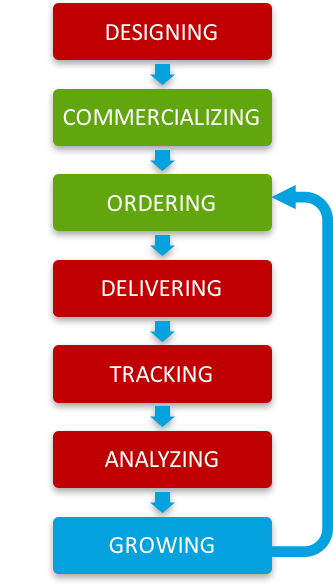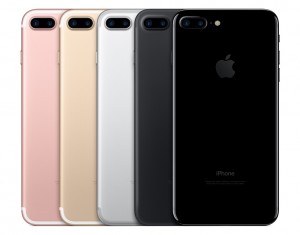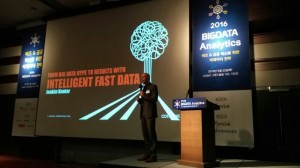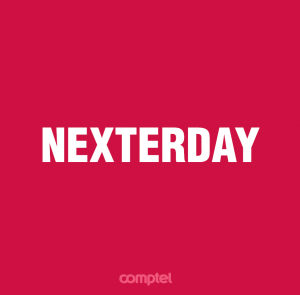
Here on the Comptel blog, we always want to give room for those big ideas to take shape. Let’s take a look back on some of the top pieces – and ideas – we wrote in the past year.
Enabling the Personalised Customer Journey
All operators are on a journey to better serve their customers. The activities they take in this area can be put into two categories – customer transformation and network transformation. In this piece, we explained exactly what the personalised customer journey is all about, and offered a model for how operators can win the hearts and minds of their customers.
Forget the iPhone. The Next Great UI Design Change is in OSS
The new iPhone UI looks a lot like the old iPhone UI, which tells you how iterative many of Apple’s latest updates have become. In this blog, we proposed that it’s time the OSS embraced a design overhaul, and explained exactly how the OSS of the future should look to offer the same ease of use you might expect from an iOS product.
Comptel Partnerships to Introduce Fresh Digital Service Approaches
2016 was also a busy year for Comptel and our partners. At TM Forum Live! in Nice, we were involved in three separate industry catalysts, each led by a Comptel partner. There was Telefonica’s Open Source MANO project, Orange’s sponsored data initiative, and IBM’s cloud-based networking architecture. These cross-industry initiatives are so important to Comptel because they keep us on the forefront of innovation. We want to lend our expertise in a way that benefits the entire industry, and we’re proud to stand alongside these partners in that effort.
Reimagining OSS to Enable Dynamic Digital Service Delivery
Our digital service lifecycle management (DSLM) model was a major theme for us in 2016, and in the Spring we put it to the test as part of the IBM Cloud Based Initiative. In this post, we explain exactly why and how digital service delivery needs to change to serve a new breed of digital customer.
Spectrum is the First Step. How Will Operators Next Invest in 5G?
Innovation abounds in connectivity, and 5G represents one of many emerging frontiers for investment and development. In the U.S., regulators opened up spectrum for telco experimentation, and in this post we covered the challenges that lay ahead for telcos who dipped their toes in this industry.
Sponsored Data is a Path to Revenue for Savvy Mobile Operators
Pokémon GO was a huge mobile gaming craze in the summer of 2016, and T-Mobile jumped on the buzzworthy topic by offering players one year’s worth of free mobile data exclusively to play the game. It was another example of a savvy sponsored data play that shows other operators how they creatively leverage data access to win over digital customers.
In 2016 we also launched Nexterday.org, our online magazine and reader community. You can read much more of our writing on digital transformation, customer experience and network innovation there.
]]>State-of-Play
There remains no doubt that virtualization is shaking the foundations of the telecommunications industry and is here to stay. As the technology continues to mature and evolve, use cases become more realistic and so do the requirements to represent the service specifications that allow their programmatic utilization and consumption.
Several standards organizations have laid proposals to this purpose and there appears to be consensus that, in the Network Functions Virtualisation (NFV) case at least, TOSCA NFV appears to be positioning itself as the preferred option for operators and vendors alike.
The Topology and Orchestration Specification for Cloud Applications (TOSCA) is a data model standard managed by industry group OASIS that can be used to orchestrate Network Functions Virtualization (NFV) services and applications. TOSCA does this through a collection of information models and templates to orchestrate applications seamlessly across multiple cloud domains which is ideal for network functions that are virtualized and deployed in datacentres.
At the time of this writing, the latest release of the TOSCA NFV Simple Profile dates from mid-March 2016. The document provides a good insight but it lacks practical, consistent examples (e.g. there are a few errors) and examples from additional sources are hard to come by. This applies to the Cloud Service Archive or CSAR (pronounced Cesar) packaging mechanism, in which the specification is conveniently wrapped with all the necessary components.
[Comptel] has taken the information that’s publicly available and created some examples that we would like to share with the broader community.
Use Case: vEPC Core Network CSAR
A basic representation of the Evolved Packet Core (EPC) Network Service Descriptor (NSD) composed of four Virtual Network Functions (VNFs) as shown in Figure 1 below. In addition, every node has a connection to a common management network.

Figure 1: vEPC Architecture & Interfaces
The CSAR file contains metadata, the service templates or specifications, images and the corresponding scripts for the VNFs themselves. Figure 2 shows the structure of the file.
As displayed in Figure 3, the metadata file contains in line 4, a pointer to the main driving template, in this case the overall vEPC NSD which will link to the individual nodes (e.g. VNFs) and their relationship and corresponding connectivity.
The Network Service Design
The NSD provides the global overview (refer to snapshot below) on how the different components (e.g. VNFs, VLs, FGs, etc.) come together. Lines 9 thru 13 point to the VNF templates, in this case for every VNF.
The individual VNFs are described in lines 26, 37, 49 and 58 respectively. They contain a reference to the type, the list of (virtual) networks they are connected to and in those cases where applicable, a declaration of the forwarding graph capabilities (e.g. lines 45, 46 and 47). Additional details on the VNF themselves are contained on their own descriptors (VNFDs) which are shown later.
Next are the details of the external connection points (CPs). These are demarcation points for the NSD as depicted in Figure 4 and they are described in lines 65, 73, 81 and 89.
Finally, the networks interconnecting the VNFs themselves. In this case, all networks are point-to-point connections (e.g. ELINE) except for the management one, which is shared across all VNFs (ELAN). Every declaration, as seen in lines 97, 108, 113, 119, 125, 131 and 137 indicates the number of network entities attached to them.
The Virtualised Network Function Descriptor
The VNFDs provide details on the specifications of the individual nodes. The vPDN GW descriptor is shown below as a reference. Starting on line 42 the connectivity is described. This VNF requires two computational resources as expressed on line 48 (VDU1 & VDU2). Two of its interfaces (CP21 & CP22) are enabled to support Forwarding Graphs (line 51). In this specific case, four standard transactions types are supported through self-contained scripts: create, configure, stop and delete (line 54). The interfaces and their respective networks can be appreciated in general the topology depicted in Figure 5.
At the end of the VNFD template are two Forwarding Paths (Line 144 and 151). They represent the incoming and outgoing traffic for the PDN gateway. Figure 6 and Figure 7 provide a visual perspective of the traffic flows they control.
NSD_vEPC.yaml – File contents:
vPDNGW_VNF.yaml – File contents:
Comments
The standards provide enough tools to cover the most general of use cases, but we expect to see future updates that can target elements of the service description that represent more complex and realistic scenarios, for instance:
- Quality of Experience (QoE) or in general Quality of Service (QoS) features. There are some brief references in the existing standards but this area requires further development.
- The transactions/interfaces need to support more complex features that can allow them to be referenced and consumed more easily by higher order service orchestration processes.
- Forwarding Graphs should include indications of the traffic types.
Although Comptel has worked out these areas for its own products and specifications, the real value materialises when these specifications become open and seamlessly interchangeable by the different components in the architecture.
]]>Digitalization has created a generation of empowered, engaged and demanding “Generation Cloud” consumers. These people want to be treated as individuals through using a service that meets their expectations and aligns to the way they live their lives. They don’t want to follow service providers’ rules but instead, define the digital market as they want to see it. Service providers have to identify product opportunities, then design and commercially publish new service offerings faster than ever. Only then will they be able to seize the increasing new opportunities for data, content, applications and service monetization. Effectively they have to monetize more in less time, whilst leveraging partner offerings for service enrichment.
How do service providers win the hearts and minds of customers with almost impossible expectations?
To meet the expectations of generation cloud consumers it’s no longer sufficient to have a static portfolio of products that a customer selects and uses unchanged for the lifetime of a contract. Lifestyles, demands and expectations create a digital opportunity for providers to continually engage with their customers with contextually relevant enrichments to a base package contract.
These enrichments or upsell opportunities can take the form of traditional data or messaging bundles, however they can now also encompass personalized add-ons such as streaming subscriptions or cloud-storage with a data allowance; time-based video streaming bundles and sponsored enterprise data packages. These modern-day enrichments have to be more understandable by the consumer, as lifestyle enhancements aligned to them.
Service providers have an opportunity to not only create these offerings but intelligently identify when to make a recommendation and with which product. They also have to simplify the engagement and buying process as closed-loop automation, allowing for consistent improvement, alignment and customer retention.
What would the perfect solution look like for CSPs to enable the personalised customer journey?
A comprehensive turnkey solution for the personalized journey will incorporate a number of steps that the customer service lifecycle will take. These steps consist of product creation based on identified market needs, campaign management and commercialization of those products, an ordering process and of course the delivery of a product in the first instance.
Once delivered it’s necessary to collect data and valuable information on the consumed service, which when analyzed provides insights to drive the intelligent recommendations required for next customer contact via a simple interaction or detailed marketing campaign.
Realizing that the recommended add-on is a perfect fit, the consumer then needs a seamless buying and delivery experience – leading to the creation of a revised automation-loop for continuous future engagement.
A Modern Day Customer Engagement Architecture
Leveraging a communications industry data integration framework, Salesforce, Apttus and Comptel are perfecting the personalized customer journey through a number of identifiable steps.
 Designing – B2C or B2B service design based on technical network and service capabilities, with input from market research created by product management.
Designing – B2C or B2B service design based on technical network and service capabilities, with input from market research created by product management.- Commercializing – Publishing of the product as a commercial offering, allowing a customer to discover, select and customize to their needs.
- Ordering – Submission of the selected and customized product as an order into the buying process. Incorporating CPQ processes (Configuration, Pricing and Quotation).
- Delivering – Order processing and service activation plus an all-important notification to the subscriber for full customer engagement into the process.
- Tracking – Continuous charging, metering and full reporting of service consumption by the subscriber, giving a 3600 perspective on contextual usage.
- Analyzing – Contextual analysis on service usage trends of the subscriber leading to intelligent recommendation for product upsell and tailoring – customer alignment and engagement.
- Growing – Perpetual engagement, offering continual recommendations to an individual and the option to buy. Perfecting the customer engagement process.
The Solution
The result is an eco-system primed solution for customer engagement and contextually-intelligent product recommendations, leading to automated customer lifecycle management. The solution is enabled by the Salesforce Communications Framework & Data Exchange, Salesforce Customer Success Platform, Apttus Quote-to-Cash solution and Comptel Intelligent Data Monetization & Customer Engagement Automation.

The tech leader rolled out the newest version of its smartphone last week, and by all accounts the latest iPhone’s features are mostly iterative than innovative. The most disruptive hardware change was also the one that frustrated consumers the most: the elimination of the 3.5 mm headphone jack, which requires iPhone users to use Apple’s proprietary headphones instead. 
Similarly, the iPhone’s user interface seems to have plateaued. While the iPhone 7 will ship with a new operating system that includes a handful of new features, the look and feel of Apple’s UI is still virtually unchanged from where it was several generations ago. You can add some more pixels here and round off a few bevels there, but for the most part, iOS doesn’t offer much opportunity for further design innovation. Apple’s UI is what it is because that’s what its devout customers expect.
That’s not necessarily a knock against Apple’s UI. They’ve found an interface that suits its fanbase, and they’ve even inspired design innovation in other areas of software development. In fact, one software experience that’s long overdue for a fresh coat of paint and user-friendly functionality is OSS.
To date, we’ve seen OSS interfaces designed around the technology in the network: topologies, hardware representations and configurations that must be manually realigned based on user. However, the emerging app- and data-driven digital economy is putting increased pressure on operator networks to be agile, dynamic and automated. Meanwhile network function virtualisation (NFV) is changing the speed and nature of service orchestration by simplifying network processes and application deployment.
Doesn’t it make sense, then, that the OSS should be refreshed to enable an agile and more productive work experience for telco operations managers?
Telco is starved for a strong, functional and distinct OSS UI. The folks who support service orchestration vary in roles, responsibilities, skill levels and professional backgrounds. OSS UIs should be designed to correspond to that variety, so that each user is able to focus only on those operational elements that they are most equipped to manage. That increases efficiency and the speed at which digital services can be developed, verified, deployed and improved.
As a result, time-to-profit goes down, while customer satisfaction goes up.
That’s why the shift toward cloud-service operational management will bring an evolution to the OSS, in the form of tailored, intuitive user experiences and subsequently increased productivity. The new OSS will be open, capable of seamlessly interacting with both telco and IT apps and their corresponding management systems. As a result, telcos benefit from a higher order platform to specify, test, publish for consumption and deliver services across virtual, physical and IT domains.
An intuitive OSS UI also supports a seamless end-to-end service lifecycle, eliminating any gaps in the process by which network resources are discovered and services are designed and deployed.
Ultimately, the new OSS recognises that virtualisation is an opportunity for telco to reinvent itself. Operators can offer more than just a telecommunications platform – they have a chance to become part of a larger, distributed IT infrastructure that seamlessly provides services to end customers. Our existing OSS culture needs to evolve in order to recognise that this paradigm shift requires opening up the infrastructure to deliver services and resources in a more agile, open and systematic way.
Comptel will discuss the reinvention of the OSS user interface paradigm in The Hague for SDN & OpenFlow World Congress, 10-14 October 2016. Contact [email protected] to connect with our team or arrange a meeting at the event.
]]>
Last month, Comptel took part in the primary annual meeting of the MEF member organisation in Boston, where we had a great opportunity to explore how our DSLM model for service orchestration complements MEF’s vision for NFV-driven service delivery and lifecycle management.
What are Third Network Services?
MEF describes Third Network Services as those that “combine the on-demand agility and ubiquity of the Internet with the performance and security assurances of Carrier Ethernet 2.0.” The organisation is essentially describing a variety of digital services that rely on optimised high-performance networks to meet the quality of service expectations of today’s digitally savvy Generation Cloud consumers.
Examples include performance-assured wired or wireless internet connectivity, which automatically optimises the performance of your network whether you’re working on a train, in your home or from a hotel room on a business trip. The Third Network also provides assured, dynamic network performance for businesses, enhancing the experience for each end user on each cloud application even if the company uses multiple internet providers across multiple offices.
The idea is to provide quality, assured service experiences that customers can control. MEF’s vision for Third Network Services closely aligns with Comptel’s own view of dynamic digital services, which is why we’re excited to bring our DSLM model to the table in conversations with MEF member organisations.
Developing LSO and DSLM
To enable these services, MEF has introduced a number of models and specifications that define how operators should evolve their networks and integrate emerging technologies, such as network functions virtualisation (NFV). Member organisations, like Comptel, take part in ongoing MEF initiatives and proofs of concept to engage with and develop these standards and models.
One such model is MEF’s Lifecycle Service Orchestration (LSO), which leans on NFV and software-defined networks (SDN) to streamline and automate “the service lifecycle in a sustainable fashion for coordinated management and control across all network domains responsible for delivering an end-to-end connectivity service,” according to MEF.
Comptel’s DLSM, which models dynamic service orchestration in an NFV-driven digital economy, complements LSO nicely. It’s a three-tiered conversational architecture in which:
- A customer-facing top layer handles order capture, configuration and invoicing
- A middle digital service lifecycle management layer offers dynamic service design, orchestration, assurance and delivery
- A bottom layer handles resource management with physical and virtual systems.
The parallel concepts of LSO and DLSM both recognise the important role virtual functions will play in the development of operator networks and the delivery of dynamic, high-performance digital services to consumers.
Comptel is eager to be part of the conversation within MEF to help define how LSO standards evolve, and we believe our ongoing involvement with MEF will help us bring a higher level of expertise to conversations with our own customers around NFV-driven service orchestration.
Learn more about DSLM in our whitepaper “Digital Service Lifecycle Management: How Communications Service Providers Can Play a Successful Role in the Digital Economy”
Comptel will be showcasing and discussing the Digital Service Lifecycle Management including their FlowOne V solution for end-to-end hybrid network service orchestration at a number of events in the coming weeks.
- At Light Reading’s NFV & Carrier SDN: SDN Integration in the Virtualized Realm Event 13-14 September in Denver.
- With Layer 123 in The Hague for SDN & OpenFlow World Congress, 10-14 October 2016
- In Baltimore for MEF16, 7-10 November at the Hilton Baltimore Inner Harbor Hotel.
To connect with our team or set up a meeting, email [email protected].
]]>Consumers want faster internet. Operators want to offer it. And now, regulators in the United States say they want to give telcos the tools to deliver it.
This month, the Federal Communications Commission (FCC) announced it would open up a range of spectrum – 28 Gigahertz, 37 GHz and 39 GHz – for the creation of the next generation of wireless services. 5G connectivity will represent a “quantum leap” in wireless capabilities, said FCC Chairman Tom Wheeler, because it promises to deliver speeds at least 10 times and possibly 100 times faster than 4G LTE.

The U.S. will be the first country in the world to open up spectrum for 5G, and there are many positive takeaways from the FCC’s announcement. First off, releasing radio spectrum is an obvious and important first step toward innovation. It creates a great opportunity for first-movers to start testing and developing new wireless technologies.
Wheeler also points out that the high-frequency bands now available to telcos support much higher traffic throughput compared to existing licensed spectrum, which will give “fibre-like” traffic capacity to wireless users. That will allow operators to dream up intriguing new services and applications.
There’s a lot to like from the FCC announcement, but of course it’s just the first step in the ongoing development of 5G. There’s a lot of work left to do to make 5G a feasible and profitable option for operators.
A Complex Regulatory Environment
Communication services providers (CSP) and network equipment providers (NEP) will need to make substantial investments to roll out 5G across the world, and they’ll need to do it fast to meet consumer demand. How will they recoup the costs of their investments?
One strategy might be to sell premium 5G-enabled services at a premium cost, but of course, those operators would need to be careful not to defy net neutrality regulations and expectations. There’s friction between regulations and operators on this issue. While FCC has ruled in favour of net neutrality, major U.S. telcos have argued that an inability to create priority services limits the funds they’d use to invest in infrastructure.
This issue should only become more pronounced with 5G. How can regulators and operators meet in the middle? There are a number examples of differentiated service models that balance private and public interests while working in parallel, such as public libraries and private booksellers, or VIP services in the hospitality industry. Regulators and operators must create an environment that encourages equal access but also offers unique opportunities for differentiated service models.
A New Infrastructure for Better Latency, Connectivity
5G connectivity is supposed to offer the network speed needed to power next-generation applications, the types that can’t afford lags or gaps in connection. A connected car, for example, needs fast internet access all of the time, whether you’re driving in a crowded urban environment or a sleepy rural community.
But solving for network speed is ultimately more of an infrastructure problem more than it is about adding spectrum. User devices will need to be moved closer to the edge of the network, which means a massive deployment of unobstructed antennas – that’s where the biggest costs related 5G deployment will be found.
How will that impact the future development of cloud infrastructure? Will it push us even faster toward global urbanization, with fewer people living in rural communities? How will investment in 5G be balanced against investments in faster fixed connections, like fibre?
Interestingly, many of the most popular use cases for 5G seem to suggest that, in the future, we’ll mostly access the internet via mobile networks. But of course, that’s not nearly the case across the world. In the United States, only 20 percent of households access the internet exclusively through mobile networks – 75 percent get it from fixed connections, according to the NTIA.
Now, the numbers are in fact slightly trending toward more mobile-only connections and fewer fixed connections in the US market. Globally, mobile broadband connections are, on average, 1.7 times cheaper than fixed-broadband, according to the International Telecommunications Union. But will operators choose to invest in both areas evenly, or favour one connection over the other? The most realistic vision for 5G connectivity might be in heterogeneous networks, a combination of wireline and wireless, where operators will be able to exercise a variety of connectivity technologies, including 5G, to deliver maximum service and experiences to customers.
Spectrum is one important piece of the puzzle that is 5G, but it’s still early days. The telco industry needs to work with regulators to solve issues around differentiated service offerings, and operators need to determine how best to change network infrastructure to support futuristic bandwidth-hungry service and applications.
]]>Most software is built in layers. At the bottom sits the technical foundation, while at the very top there’s a user interface that connects man with machine. Most software users never actually deal with the technical layer – they’re happy as long as the software’s foundation works efficiently and as it should. 
Instead, most user interactions occur on the surface layer, but that’s not always where developers and businesses focus their attention. A lot of development time is spent shoring up a product’s technical foundation, and while it’s very important to create a functional product that’s built on strong footing, a subpar user interface is not enough. Users need more than that. And a major challenge is that a product’s usability is invisible by nature and usually only gains attention when something is missing.
The User is Number One
What is usability in a nutshell?
The essence of it is to think about the usage of a product or service from the user’s point of view and consider the optimal way of interacting with the product to achieve maximum end-user benefits. It’s about enabling the use of a product or service to be as easy, as pleasant and as efficient as possible. It’s about simplifying complex things.
Users need products that are easy to learn and to use, that eliminate error-prone conditions, that create meaningful experiences, and, not to forget, that are pleasant to look at. Products need to make sense and answer the needs of users.
Users want products to be as fluent as possible, saving their time and, in the corporate world, saving their money. This need is universal no matter the software’s target group or ideal customer, whether it’s a private individual or a big global telco company.
So, how do software developers get to the point where their product’s users enjoy both maximum technical performance as well as great product usability?
One has to bear in mind that great product usability, as abstract as it sounds, is not a complementary asset – it’s an integral must-have quality for any service or software. The process of ensuring a service or software has the best possible usability goes alongside the whole development process, from requirements gathering all the way to delivery and beyond.
A Focus on Usability Saves Money
It’s not only end-users that benefit from an integrated approach to addressing software usability. Developers and businesses stand to benefit, too.
By utilizing user-centric design methods from the beginning, it’s easier for developers to track what customers want and compile a comprehensive list of product requirements. In fact, it would be beneficial for all parties, if possible, to have continuous communication between customers and the user experience design team to track satisfaction with a product’s usability and features.
After feedback is received and new product requirements determined, continuous end-user feedback and validation during the design and development stages will ensure faster progress and earlier resolution of design flaws or feature missteps. Failing fast saves development time and money.
How Comptel Addresses Product Usability
The Comptel user experience design team utilizes user-centric design methods that aim at taking the end-user into account from the very beginning of the design process. The range of different methods is vast, varying from user interviews to focus groups, workshops and co-creation. End-users and experts are an integral part of the design process and their knowledge is being utilized at all phases. We aim to achieve continuous dialog with our end-users.
Usability Can Also Be a Competitive Asset
Let’s not forget that Comptel is not the only business operating in the area of telco software development. We always ask ourselves: How can we differentiate from the other providers in this highly competitive environment? What makes us better?
When a software’s technical performance, feature list and price are approximately on the same level, it’s the surface-level usability that makes the difference to customers. So we work to deliver a superior user experience that customers know is quintessentially Comptel.
You can’t create a world-leading software product without offering both great technical performance and a great user experience. And you can’t deliver a great user experience without supreme product usability. These factors combined equal quality. And quality is our key driver.
]]>
The app has been a pop culture sensation since launching in the U.S., Australia, the U.K. and New Zealand. It’s the biggest mobile game in U.S. history, and enjoys 21 million daily users on average. The average mobile iOS user spends more time on the Pokémon GO than they do Facebook, Snapchat, Twitter and Instagram.
That level of engagement for a brand-new app is extraordinary. Recognising that fact, T-Mobile U.S. rolled out a compelling offer for its mobile subscribers as part of its “T-Mobile Tuesdays” campaign: free, unlimited data to play Pokémon GO for up to one year.
T-Mobile has been at the forefront of programs that make data available to subscribers for free. Its “Binge On” program allows customers to access more than 75 streaming video services without using their monthly 4G LTE data allotment.
Customers love streaming content and games, but they are reluctant to engage with certain activities because it’s perceived they might consume too much of their data allowance. Sponsored data programs let them engage with those services because the cost of data consumption is covered by an enterprise, such as the content provider.
Through agreements with streaming content providers or mobile app developers, operators remove the financial barriers that might have discouraged customers from accessing these data-hungry services. As an effective monetisation strategy, sponsored data endears you to your customers, establishes greater levels of satisfaction and loyalty, increases data consumption and creates long-term revenue-generation opportunities.
At this past TM Forum Live! in Nice, we demonstrated a business model for enterprise sponsored data through a Catalyst championed by Orange. Our initiative – which was awarded “Most Innovative Catalyst – Commercial in the Communications Industry” – used Comptel’s Intelligent Fast Data capabilities to create personalised data offerings for enterprise customers, allowing those enterprises to collect usage data and apply policy control.
It’s not just streaming content providers who can get involved. Operators could identify new avenues to revenue in the B2B market. A business could purchase a corporate data allowance, for example, that sponsors all data its employees use to access corporate services, like Office 365, via their personal mobile devices. That eliminates any potential hesitancy on the part of employees, who otherwise may not want to use up their personal data allowance for work purposes.
Whether for work or play, sponsored data programs could be a major opportunity for operators to drive more revenue opportunities from data services. As digital services take up a bigger share of smartphone usage compared to voice and mobile, these new avenues to revenue will be crucial for operator business growth.
Read more about Comptel’s Catalysts at TM Forum Live! 2016, which included partnerships with Orange, Telefonica, Salesforce and IBM. Keep up with the conversation around mobile monetisation at Nexterday.org, our reader community and online magazine.
]]> amples and technologies, and to share experiences. Comptel had the pleasure of joining Team Finland with a speaker slot together with IOT specialists BaseN and Wirepas.
amples and technologies, and to share experiences. Comptel had the pleasure of joining Team Finland with a speaker slot together with IOT specialists BaseN and Wirepas.

We’ve published Nexterday: Volume II, a follow-up to our previous book, Operation Nexterday. You can pick up a hard copy of the book at this year’s Mobile World Congress or download a digital version by visiting our new online magazine and community, Nexterday.org. With this edition, our goal is to help each operator become a “Perfect Digital Company,” one that works for and with its customers to enhance the digital moments that make up life.
To achieve that, operators need to open their minds to fresh ways of thinking about serving customers, taking inspiration from their counterparts across the globe and visionary, non-telco businesses that are changing the face of digitalisation.
The Customer is in Charge
Generation Cloud is, as always, at the centre of the digital struggle. B2B and B2C customers crave the autonomy to customise, configure and purchase digital services at a faster pace and on their own terms. On top of that, operators are increasingly starting to play in non-traditional markets, including connected devices, smart cities and healthcare, in both established and emerging markets.
Technology advancements – from the introduction of and ongoing management needs for virtualised network functions to the rising importance of real-time data in sales, marketing and service management – mean operators have more tools at their disposal to serve buyers’ unique interests and succeed in new verticals.
The challenge is determining how to effectively leverage these tools, while also applying the creativity and radical ideas operators need to distinguish their service at a time when customers are willing to switch digital and communications service providers at a moment’s notice. It’s not just about offering dynamic new services, but also delivering those services as part of a more pleasant and fulfilling customer experience.
Creating Perfect Digital Moments
Nexterday: Volume II describes how your business can evolve to meet the needs of a changing digital economy. The book includes:
- Inspiring real-world examples of telco and non-telco businesses that strive to offer customers extraordinary digital experiences
- Perspectives on the qualities of leading digital businesses from economist Dr. Kjell Nordström and business experts Stefan Moritz, Mark Curtis and Jeetu Mahtani
- In-depth research from analysts Stewart Rogers, Fredrik Jungermann, Caroline Chappell and Steve Bell
- Blueprints on how operators can automate their enterprise sales approach, pursue Internet of Things (IoT) service opportunities, create a richer B2C customer experience and re-engineer their back end for accelerated service delivery and enhanced digital service lifecycle management
Though we believe strongly in the themes we cover in the book, we want it to inspire a rich dialogue about the state of our digitalisation. We invite book readers to visit Nexterday.org to share their opinions and challenge our thinking. Whether you agree or disagree, we want to hear from you at Nexterday.org. Registration is simple: just sign up with your LinkedIn account.
Nexterday: Volume II, which will be available in hard and digital copies, will be officially released at our #Nexterday party on Wednesday, 24 February at 7 p.m. CET during Mobile World Congress. We’ll have live performances, an open bar and plenty of opportunities to unwind and mingle. You can pick up an exclusive ticket at the Comptel booth (stand 5G40 in hall 5). If you are not attending Mobile World Congress, you can download a digital copy of the book at Nexterday.org.
We invite you to join the movement and become a ‘Perfect Digital Company’ that serves the best interests of its customers. Nexterday: Volume II will show you how.
]]>











